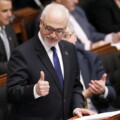Trevor Tombe, a leading economist and fiscal policy expert at the University of Calgary, has raised significant concerns about the Liberal Party’s election platform, warning that its spending plans would deepen Canada’s deficits and abandon the government’s own fiscal commitments.
In a recent interview on The Hub’s election YouTube show, Tombe dissected the platform’s financial projections, highlighting risks that he says could further destabilize Canada’s economic outlook.
Here are the three key takeaways from the discussion:
- The Liberal platform abandons fiscal discipline, projecting higher deficits and rising debt: The Liberal platform’s spending plans would increase the deficit by $21 billion over PBO projections by 2028, reversing the government’s commitment to reducing debt-to-GDP.
- Unrealistic savings targets and economic vulnerabilities threaten fiscal stability: Tombe says the platform assumes $13 billion in annual “productivity savings” without extensive details, while ignoring risks like a U.S. trade war or recession—either of which could balloon deficits further.
- Questionable accounting of capital spending and overstated growth benefits: The Liberals labelled $53 billion as “capital spending,” blurring the line between true investments and routine costs. Tombe warns that economic multipliers are likely negligible and that crowding out private investment is a real risk.
Abandoning fiscal discipline, projecting rising debt
Tombe compared the Liberal platform’s fiscal projections to the Parliamentary Budget Office’s (PBO) baseline estimates. While the PBO forecasted deficits declining to
$25 billion by 2029, this is based on the Liberal plan separating the operating balance and capital spending. If the two were not separated, Tombe argues there will be a deeper deficit of $48 billion by 2028. This represents about a $21 billion increase over the PBO’s projections.
Crucially, the platform discards the government’s previous commitment to reducing the debt-to-GDP ratio, a key fiscal anchor designed to ensure long-term sustainability. Instead, the Liberal plan would see debt-to-GDP rise, contradicting, says Tombe, their own past emphasis on maintaining Canada’s AAA credit rating and low borrowing costs.
“What we see in this platform is that now, with these pretty dramatic increases in projected deficits, the debt-to-GDP ratio, instead of pointed down, is pointed up,” Tombe said.
Unrealistic savings targets threaten fiscal stability
Tombe says the Liberal platform includes ambitious plans to achieve $13 billion in annual savings through “increased government productivity”, yet provides no concrete details on how this would be accomplished. Tombe expressed skepticism, noting that achieving the planned rate of annual savings (from $6 billion to eventually $13 billion) currently lacks transparency. If these efficiency savings do not come to pass then the deficit will remain around the $60 billion mark, Tombe estimated.
Additionally, the platform assumes stable economic conditions, ignoring significant risks, including trade disruptions with the U.S. A potential trade war could slow GDP growth, and if growth happens 1 percentage point slower, that increases the federal deficit by $5 billion. Recession risks also exist, as the government’s own “downside scenario” would add $11 billion to this year’s deficit and over $13 billion to next year’s.
“Any kind of slowdown in economic activity would see a deterioration of these projections,” Tombe warned.
Questionable accounting of capital spending
The Liberal platform reclassifies $53 billion in spending as “capital”—far exceeding Statistics Canada’s official measure of $16.6 billion. Tombe questioned this accounting, arguing that not all spending labeled as “investment” (e.g., education, maintenance) actually matches the definition of capital investment set out by Statistics Canada.
He also challenged the platform’s plan to “put money on the table,” which the party says would lead to more private sector investment. While infrastructure like pipelines or dams may justify debt financing due to generational benefits, Tombe cautioned that displacing private investment and economic activity is a potential issue. Additionally, multipliers are likely overstated, as Canada’s small, open economy means stimulus spending often strengthens the dollar, offsetting gains through reduced exports.
“I tend to think the multiplier is really small in Canada, potentially zero,” Tombe said. He emphasized that growth benefits only arise when spending addresses clear market failures.
Generative AI assisted in the production of this summary. If you are quoting from or referencing this summary, please refer to the audio to verify.








